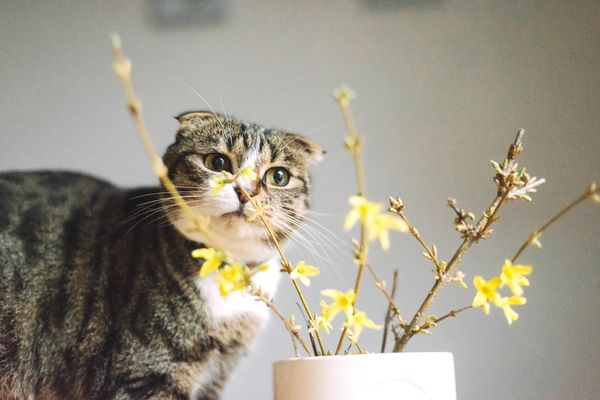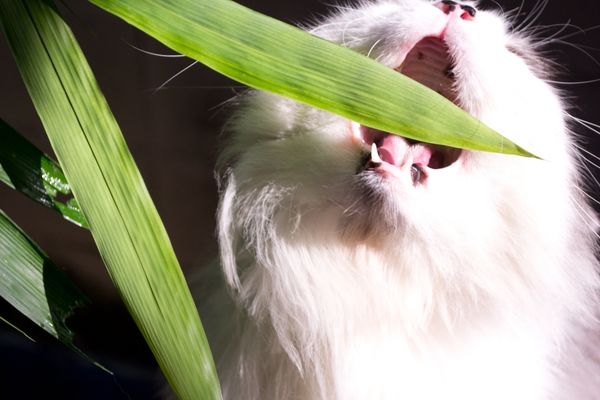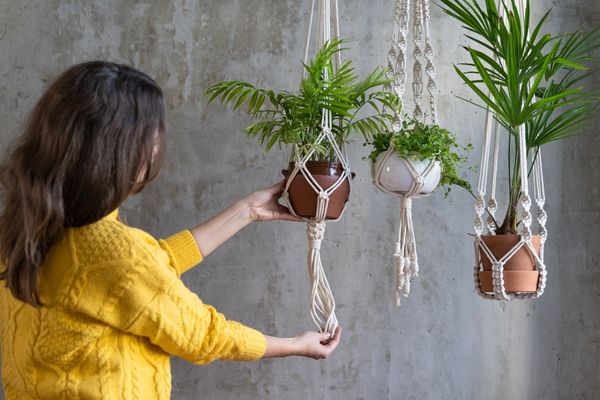Adopting a cat is a fascinating and magical journey for any new cat parent. Until, that is, you realise that your precious new kitten loves to destroy every beloved indoor plant in your house. Without the right checks and balances to cat-proof your indoor plants, you’re inviting daily dramas of torn leaves, nibbled stems, and dug-up soil all over your rugs—and that’s the best case scenario. In some unfortunate cases, house cats can suffer a fatal reaction to plants that are not cat-friendly. More on that later, but for now, if you’re a cat parent who wants to enjoy kitten belly rubs without forsaking beautiful indoor greenery, you’ve come to the right place. In this Waldo’s Friends article, we suggest tips and tricks to cat-proof your indoor plants—all without harming your new best friend.
This blog post delves into:
- Why cats are attracted to plants
- How to cat-proof your indoor plants
- Other things to remember before bringing home indoor plants
Why cats are attracted to plants
Curious by nature, your cat may have multiple reasons why she is drawn to your houseplants. Common reasons include being attracted to the taste of the plant, or loving the texture of the fronds against her tongue. Fiber-rich plants even help with digestion and induce vomiting, so it’s unsurprising that some cats chew on them. In other cases, cats may be excessively eating plants because of an underlying gastrointestinal problem. Food allergies and inflammatory bowel disease are examples of stomach issues your cat may be trying to alleviate on her own.
In addition, cats may also play with plants due to behavioural causes. They can be bored with their toys and scratching posts, and may lash out through destructive behaviour. They may also be doing this to get their owner’s attention and attend to their needs. Worse, they may be feeling stressed or anxious and need an outlet to release their pent-up emotions.
Before trying these different cat-proofing techniques below, take a moment to observe your cat. Figure out the possible reasons why she plays, chews, or destroys a particular indoor plant. Then, share your observations with the veterinarian. Together, you can find effective cat-proofing solutions based on your cat’s personal preferences and habits.

How to cat-proof your indoor plants
There are many ways to deter your cat from getting her paws on your beautiful houseplants. You can engage with her five senses to make the seemingly impossible happen. Try them all to discover what works best for your cat, then combine the most effective ways.
Smell
Compared to humans which have about five million olfactory receptors, cats have 45 to 80 million scent receptors. (Some reports go so far as to say that they have up to 200 million.) Since their sense of smell is about 16 times stronger than ours, they’re highly sensitive to strong fragrances.
1 Try mixing citrus juice (such as lemon or orange) with water, then spraying the solution on the plant’s leaves. Make sure to dilute the juice to prevent gastrointestinal upset. On the other hand, refrain from using the citrus fruit’s peel or essential oil extracts. These may cause stomach-related problems or make her skin sensitive to sunlight.
2 Aside from a citrus juice-water solution, combining water with apple cider vinegar can deter cats and even pests such as ants, slugs, and snails. However, some studies indicate that it’s not safe to spray the solution directly on plants as it may damage or kill them. Instead, you should only spray its surrounding areas.
3 In addition to unappealing scented sprays, some plants emit naturally strong scents that cats dislike. If you’re considering buying those kinds, try potted rosemary, lavender, lemon thyme, rue, and scaredy cat plants.
TIP: Do not use spicy pepper powder to keep a cat away from your indoor plants. This can cause complications such as upset tummy, vomiting, watery eyes, and runny nose.
Taste
With only 470 taste buds, cats can only experience a limited amount of flavours. These are sour, bitter, salty, and umami flavours.
4 Since most cats are not fond of bitter flavour, you can opt to buy commercially sold bitter sprays. Because of their unappealing taste, these animal-safe sprays can help prevent cats and even dogs from chewing on your plants.
5 In addition to applying bitter spray on the top and undersides of the plant’s leaves, you can divert her attention by offering feline-safe plants or grass kits that she can eat. Catnip and catmint are two examples of non-toxic herbs they can have in moderation. Just make sure the plants she can chew on are nowhere near your prized greens.

Touch
Your cat’s adorable, jelly bean-shaped paws are packed with sensitive nerve receptors. These help your pet feel differences in texture, pressure, and temperature.
6 If you own a cat that enjoys digging in the soil of your potted plants, make it difficult for her to access it. Place rough textures over the soil such as landscape fabric or burlap cloth, and spray it with your preferred deterrent.
7 Aside from coarse fabrics, placing decorative stones, tiny pebbles, or pine cones over planters can also discourage digging as they create uneven surfaces. Cats will hate the feeling on their paws as they dig through and try to reach the soil.
8 Anti-scratch deterrent tape is another alternative that will prevent cats from getting their paws into your plants. Restrict her access to the soil by placing a layer of the sticky tape over a place mat that’s cut to the size of your pot.
9 For cats that enjoy eating or playing with the plant’s leaves, turn over a piece of carpet and use its backing (or the underside). Position your planters at the center of the rug. The rough surface will feel uninviting for your cat, making her less likely to step on it and get close to your plants.
10 Stop your pet from accidentally knocking over and dropping your potted possessions. Do this by placing them in hard-to-reach areas (more on this in the See section) and keeping each pot in place with sticky tack or putty.
11 In addition to rough surfaces, plants known for having prickly parts or sharp thorns may be huge turn-offs for cats. Try purchasing roses and succulents (remember to pick varieties safe for cats!) and see how she reacts to them. A “sacrifice plant” such as a spider plant with long leaves may also keep cats busy chewing on their fronds and ignoring other pots.
Hear
Cats are not fond of loud, sudden, and strange noises. Some feline pets are extra sensitive to sound, and may display fear and other exaggerated responses. These include having dilated pupils, hairs stand on end, and ears flattened back. She may also run off and hide in a safe space.
12 Aluminum foil works double duty to deter pets, so you can use it to your advantage. The shiny, smooth texture as well as the high-pitched crinkly sound it makes can irritate both their paws and ears. Crumpling the foil and placing it around the plant’s soil does the trick, even if it may not look aesthetically pleasing.
13 Fill a metal container with coins or pebbles. Whenever your cat tries to get close to your indoor plants, shake it to produce a rattling sound. The noise will discourage her from approaching your plants.
See
Cats are nearsighted creatures with vision perfect for hunting and capturing prey. Objects or people need to be about six metres away for a cat to be able to see them clearly.
14 As the saying goes, “Out of sight, out of mind.” The easiest way to stop a cat from playing with your indoor plants would be to place them in a special, cat-free room.
15 If a room devoted to plants isn’t possible, you can position them in inaccessible areas throughout your home. Hang them from the ceiling in rope plant holders or beautiful bird cages. Place them on high shelves or elevated sections. Or use an old fish tank or a glass cabinet as a terrarium. This allows you to keep them safe and on display at the same time.

Other things to remember before bringing home indoor plants
Always consult with your veterinarian and/or a reliable source before you decide to grow or take home a new plant for your indoor and outdoor spaces. You want to be 100% sure it’s safe for your cat, especially if you own a curious one that likes to touch, bite, or chew on things.
Moreover, you can search through the comprehensive list of toxic and non-toxic plants for cats prepared by the American Society for the Prevention of Cruelty to Animals (ASPCA). In it, they share the common and scientific names of a plant, the family it belongs to, and how it looks. They also reveal if it’s harmful for cats, dogs, or horses, the toxic principles found in it, and the symptoms animals may exhibit.
ASPCA also reminds cat parents that any type of plant-based consumption can lead to vomiting and gastrointestinal upset, even if they’re listed as non-toxic. It all depends on how much your cat has eaten, her digestive capacity, and other health conditions she may have.
If you suspect that your pet cat came into contact with or ate a poisonous plant, contact your vet or the animal emergency clinic immediately. Don’t wait to see her symptoms get worse as some plants and flowers consumed in small amounts can bring about severe acute kidney failure.
Whether you want to purify the air or simply beautify your interiors, indoor plants can coexist peacefully with cats. It helps to positively reinforce your pet with praises and treats, train them to ignore your planters, and divert their attention to more engaging pursuits. Start by making her homemade toys or building an enriching catio (you can even add plants to it!).
Leave a comment
Your email address will not be published. All fields are required.